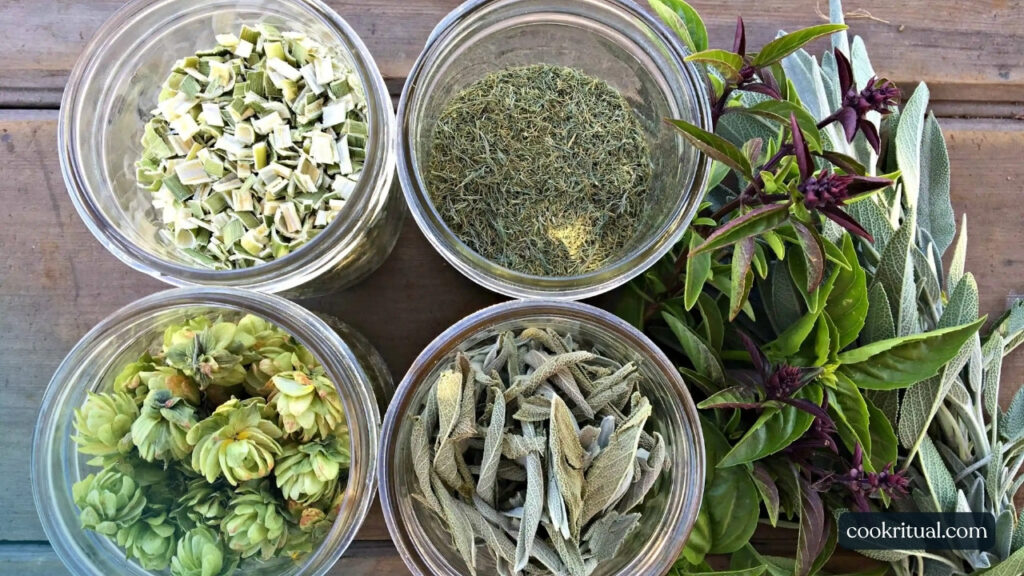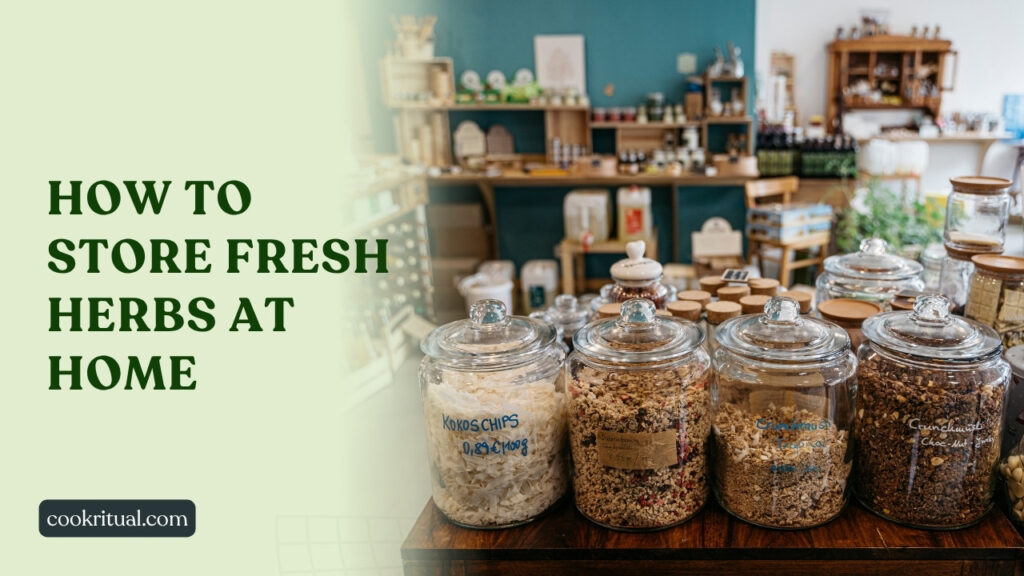Storing fresh herbs the right way can extend their life from just a few days to a week or more—while keeping their flavor and nutrients intact. Whether it’s basil for pasta, cilantro for tacos, or mint for a refreshing tea, herbs are the unsung heroes of healthy, flavorful meals. But if you’ve ever opened the fridge to find wilted, soggy greens, you’re not alone.
We’ve all been there—buying a fresh bunch of parsley or dill with good intentions, only to toss half of it in the trash days later. The good news? With a few simple techniques and the right storage tools, we can keep our herbs vibrant, fragrant, and ready to elevate any dish.
In this guide, we’ll walk through the best ways to store fresh herbs at home, from fridge hacks to freezing and drying methods. We’ll also share pro tips from real kitchen experience, product recommendations, and even a quick-reference chart for storing popular herbs. Let’s make food waste a thing of the past—and keep those greens fresh for longer!
Contents
- 1 Understanding Fresh Herbs: Types and Shelf Life
- 2 Best Practices for Storing Fresh Herbs in the Fridge
- 3 How to Freeze Fresh Herbs for Long-Term Storage
- 4 Drying and Dehydrating Herbs at Home
- 5 Choosing the Right Containers for Herb Storage
- 6 DIY Herb Storage Hacks and Maintenance Tips
- 7 Herb-by-Herb Storage Guide
Understanding Fresh Herbs: Types and Shelf Life
Soft Herbs vs. Woody Herbs: What’s the Difference?
When it comes to storing herbs, knowing the type matters. Soft herbs like basil, cilantro, parsley, and mint have tender stems and leaves. They’re usually added at the end of cooking to preserve their fresh flavor.
On the other hand, woody herbs such as rosemary, thyme, oregano, and sage have firmer stems. They hold up better to heat and are often used early in the cooking process.
Understanding this basic difference helps us choose the best storage method. Soft herbs need more moisture and delicate care. Woody herbs last longer and are easier to dry.
How Long Do Fresh Herbs Last?
Fresh herbs don’t stay fresh for long—unless stored properly. Here’s a quick guide:
- Soft herbs last about 3 to 5 days in the fridge without proper storage.
- Woody herbs can stay good for 7 to 10 days, especially if kept dry and cool.
Want to know the science behind herb spoilage? The USDA explains how improper storage causes herbs to wilt, rot, or lose flavor.
Best Practices for Storing Fresh Herbs in the Fridge
Use Damp Paper Towels to Keep Herbs Fresh
One of the easiest ways to store herbs in the fridge is to wrap them in a slightly damp paper towel. This method helps control moisture, which keeps herbs from drying out or getting slimy.
Here’s how:
- Rinse herbs gently under cold water.
- Pat them dry.
- Wrap in a damp paper towel.
- Place inside a resealable bag or airtight container.
- Store in the fridge’s crisper drawer.
This works best for parsley, cilantro, and chives. Avoid soaking the towel too much—excess moisture can lead to mold.
Storing Herbs in Water (Like Flowers)
Some herbs do better when treated like cut flowers. Just like a bouquet, we can store herbs like basil and mint in a glass of water on the counter or fridge.
Steps:
- Trim the ends of the stems.
- Place in a jar with about an inch of water.
- Loosely cover with a plastic bag (optional).
- Change water every 1–2 days.
Note: Basil prefers room temperature. Cold air can turn its leaves black, so keep it out of the fridge if possible.
Avoid These Common Mistakes
- Don’t store wet herbs directly in sealed containers—they’ll rot fast.
- Don’t place herbs near the back of the fridge where it’s too cold.
- Don’t forget to check for spoiled leaves—they can spread decay.
How to Freeze Fresh Herbs for Long-Term Storage
The Ice Cube Method (Olive Oil or Water)
Freezing herbs is perfect for long-term use, especially for parsley, dill, thyme, and oregano. Our favorite method? Freeze chopped herbs in ice cube trays with olive oil or water.
Here’s how:
- Wash and dry the herbs.
- Chop them finely.
- Add to an ice cube tray.
- Fill with water or olive oil.
- Freeze overnight, then transfer cubes to a freezer bag.
This method makes it easy to drop a flavor cube into soups, stews, or sautés. According to Harvard T.H. Chan School of Public Health, herbs like these add not just flavor—but antioxidants too.
Use Airtight Containers or Freezer Bags
Another option is to flash-freeze whole leaves on a baking sheet, then transfer to an airtight freezer-safe container. This helps herbs retain their color and aroma.
Pro tip: Label each container with the herb name and freezing date. Herbs can last up to 6 months in the freezer without losing much flavor.
When to Freeze Instead of Refrigerate
If you bought a big bunch and can’t use it all within a week, freezing is the best option. It saves money, reduces waste, and gives us easy access to herbs year-round.
Drying and Dehydrating Herbs at Home

Air Drying vs. Using a Dehydrator
Drying is one of the oldest and most effective ways to preserve fresh herbs. It removes moisture and prevents mold, helping herbs last for months.
Air drying works well for woody herbs like thyme, rosemary, oregano, and sage. Just tie small bunches with string and hang them upside down in a dry, warm place with good air flow.
If you want faster results, try a food dehydrator. It dries herbs evenly and quickly, especially when humidity is high.
For both methods:
- Harvest herbs before flowers appear (that’s when flavor is best).
- Remove damaged or yellow leaves.
- Avoid drying in direct sunlight, which can fade color and taste.
Step-by-Step Instructions for Drying Herbs
- Rinse herbs gently under cool water.
- Shake off extra water and pat dry.
- Gather into small bunches and secure with twine.
- Hang upside down in a well-ventilated room.
- Let dry for 1 to 2 weeks or until leaves crumble easily.
Once dry, remove leaves from stems and store them in airtight jars away from heat and light.
Storage Tips for Dried Herbs
Dried herbs should be kept in glass containers with tight-fitting lids. Use a label with the herb’s name and drying date. Most dried herbs stay fresh for 6 to 12 months.
The University of California’s Division of Agriculture and Natural Resources recommends storing dried herbs in a dark pantry or cabinet for best results.
Choosing the Right Containers for Herb Storage

Best Containers for Keeping Herbs Fresh
The right container can make a big difference in how long herbs stay fresh. For the fridge, choose:
- Glass jars with water (ideal for basil and mint)
- Reusable herb keepers like the ones from OXO or PrepWorks
- Silicone zip bags or BPA-free containers
Make sure the container is easy to clean and doesn’t trap too much moisture. For frozen herbs, use freezer-safe bags or stackable airtight containers.
What to Look for in an Herb Storage Container
Here’s what makes a good container:
- Airtight seal to prevent air and moisture
- See-through sides so you can monitor freshness
- Compact design to save fridge or freezer space
- Easy-to-open lids for quick access while cooking
These features help protect herbs from spoiling early and make weekly meal prep easier.
Store-Bought vs. DIY Options
You don’t always need fancy tools. A mason jar with a bit of water and a loose plastic bag can work just as well as store-bought herb keepers. However, store-bought containers tend to keep herbs fresh for twice as long, especially in busy kitchens.
DIY Herb Storage Hacks and Maintenance Tips
Simple DIY Ideas for Storing Fresh Herbs
You can make your own herb storage system using things you already have:
- Wrap herbs in damp paper towels and store in a zip bag
- Use old jam jars to hold herbs upright in water
- Reuse produce containers as herb boxes
These budget-friendly tricks can extend freshness without needing to buy anything new.
How to Prep Herbs Before Storing
Always prep herbs the right way before storing them:
- Rinse under cold water to remove dirt or bugs
- Shake or spin dry (use a salad spinner if you have one)
- Trim the stems if needed
- Remove any bruised or yellow leaves
Clean herbs last longer and taste better when cooked.
Mistakes to Avoid When Storing Herbs
- Don’t seal wet herbs in an airtight bag—they’ll rot fast
- Don’t store basil in the fridge—cold temps turn it black
- Don’t forget to check herbs every 2–3 days for signs of spoilage
By avoiding these small mistakes, we can get the most flavor and shelf life out of every bunch.
How to Revive Wilted Herbs
If herbs start to wilt, don’t toss them! Try this:
- Place soft herbs in ice water for 10 minutes
- Trim the stems and store them in a jar of fresh water
- Use wilted herbs in cooked dishes like soups or stir-fries
According to Mayo Clinic, cooking with herbs—even ones that aren’t picture-perfect—can still boost flavor and nutrition.
Herb-by-Herb Storage Guide
Quick Reference Chart for Popular Herbs
Here’s a quick chart to help you store fresh herbs the right way based on their type:
| Herb | Type | Best Storage Method | Shelf Life |
| Basil | Soft | In water at room temperature | 5–7 days |
| Cilantro | Soft | In water, covered, in the fridge | 7–10 days |
| Parsley | Soft | Wrapped in damp paper towel | 5–7 days |
| Mint | Soft | In water at room temperature | 5–7 days |
| Dill | Soft | Wrapped in damp paper towel | 5–6 days |
| Thyme | Woody | Wrapped dry or air-dried | 1–2 weeks (fresh) |
| Rosemary | Woody | In a zip bag, dry in the fridge | Up to 2 weeks |
| Sage | Woody | Wrapped in dry paper towel | Up to 2 weeks |
| Oregano | Woody | Dry in a paper towel or dehydrate | 10–14 days (fresh) |
For more storage help, the National Center for Home Food Preservation offers tested methods for drying and storing herbs safely.
FAQs About Storing Fresh Herbs at Home
Can You Store Herbs in the Freezer Without Oil?
Yes! Simply chop the herbs, spread them on a baking sheet, and freeze them. Once frozen, transfer to a freezer-safe bag or container. This works well for dill, parsley, and cilantro.
Should You Wash Herbs Before Storing Them?
It’s best to wash herbs right after buying. Use cool water and dry thoroughly. The University of Minnesota Extension recommends drying herbs before storage to reduce bacteria and mold growth.
Why Does Basil Turn Black in the Fridge?
Basil is sensitive to cold. Refrigerators are often too cold for it, which causes the leaves to darken and wilt. Keep basil on the counter in water, away from direct sunlight.
Can You Dry Soft Herbs Like Cilantro or Parsley?
Yes, but they lose flavor more quickly than woody herbs. Freezing is a better choice for soft herbs if you want to preserve taste and texture.
How Do You Know When Fresh Herbs Go Bad?
Look for signs like:
- Yellow or brown leaves
- Slimy stems
- Off smells or mold
If any part looks spoiled, toss it out to avoid contaminating the rest.
Recommended Products and Tools for Herb Storage
Best Tools to Keep Herbs Fresh
You don’t need fancy gear, but a few smart tools can help:
- OXO Herb Keeper – keeps herbs upright and hydrated
- Salad spinner – dries herbs quickly without bruising
- Glass jars – perfect for water storage or dried herbs
- Freezer-safe silicone trays – ideal for herb ice cubes
All of these are easy to clean, reusable, and found online or in local kitchen stores.
Where to Buy Quality Herb Storage Supplies
You can shop herb storage tools at trusted sites like:
- Amazon – search “herb keeper” or “herb storage container”
- The Container Store – for BPA-free and stackable options
- Target – affordable storage kits for busy kitchens
Buying the right tools can make storing herbs simpler, faster, and more sustainable.
Conclusion: Store Smarter, Cook Fresher
Properly storing fresh herbs at home helps us waste less, cook better, and save money. Whether we’re wrapping parsley in a damp towel or freezing extra dill, a little care goes a long way. By using simple tools, following safe storage tips, and choosing the right method for each herb, we can keep our greens fresh and full of flavor.
Looking to level up your kitchen habits? Download our free weekly meal planner or follow us for more smart cooking tips. Fresh herbs deserve a spot in every healthy kitchen—and now we know how to keep them fresh for longer.


